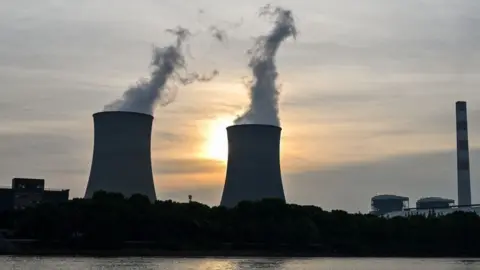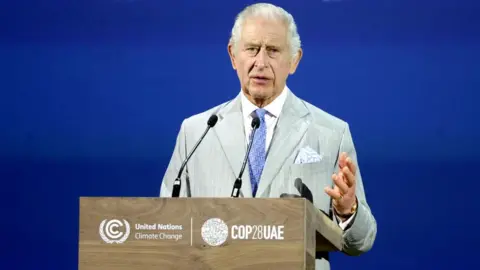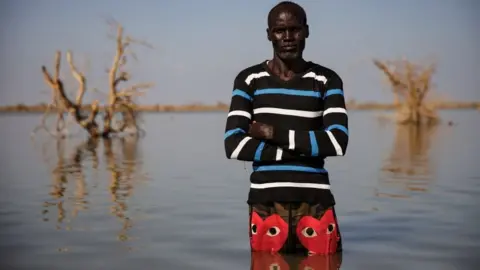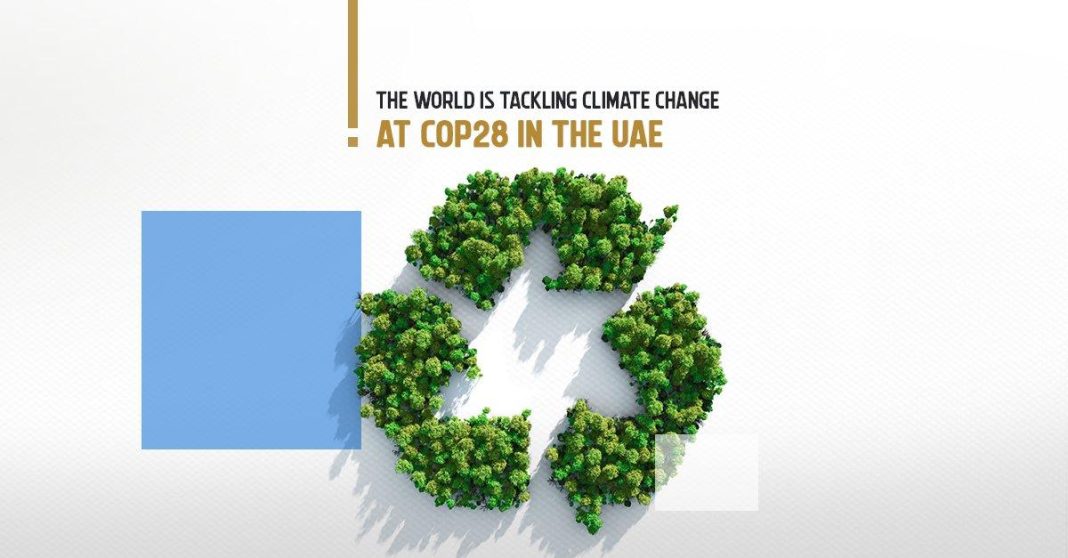World leaders have reached a new agreement to tackle climate change at a big UN meeting in Dubai.
The summit followed a year of extreme weather events in which many climate records were broken.
What was COP28 and where was it?
COP28 was the 28th annual United Nations (UN) climate meeting, where governments discuss how to limit and prepare for future climate change.
The summit took place in Dubai, in the United Arab Emirates (UAE). It was scheduled to last from 30 November to 12 December 2023, but overran by a day.
What does COP stand for?
COP stands for “Conference of the Parties”, where the “parties” are the countries that signed up to the original UN climate agreement in 1992.
Why was holding COP28 in Dubai controversial?
The UAE is one of the world’s top 10 oil-producing nations.
It appointed Sultan al-Jaber, chief executive of the state-owned oil company, as COP28 president.
 Getty Images
Getty ImagesOil – like gas and coal – is a fossil fuel. These are the main causes of climate change because they release planet-warming greenhouse gases like carbon dioxide when burned for energy.
Mr Jaber’s oil company is expected to rapidly expand production this decade.
Documents leaked to the BBC also suggested the UAE planned to use its role as COP28 host to strike new oil and gas deals.
Mr Jaber previously argued that he was uniquely well-placed to push for action from the oil and gas industry.
He said that as chairman of renewable energy firm Masdar, he had overseen the expansion of clean technologies like wind and solar power.
What was agreed at COP28 about fossil fuels?
For the first time, countries agreed on the need to “transition away from fossil fuels in energy systems”.
The text calls for this to be done “in a just, orderly and equitable manner”. This is seen as an important recognition that richer countries are expected to move away from coal, oil and gas more quickly.
However, the deal doesn’t compel countries to take action, and no timescale is specified.
 Getty Images
Getty ImagesMany groups – including the US, UK, EU and some of the nations which are most vulnerable to climate change – had wanted a more ambitious commitment to “phase out” fossil fuels.
The agreement includes global targets to triple the capacity of renewable energy like wind and solar power, and to double the rate of energy efficiency improvements, both by 2030.
It also calls on countries to accelerate low- and zero-emission technologies like carbon capture and storage.
Why was COP28 so important?
COP28 came at a crucial time for the key target to limit long-term global temperature rises to 1.5C.
The Paris commitment is crucial to avoid the most damaging impacts of climate change, according to the UN’s climate body, the Intergovernmental Panel on Climate Change (IPCC).
However, before the final deal was agreed at COP28, there were warnings that the world is actually on track for around 2.7C of warming by 2100.
Recent progress had not been in line with what was required, the UN said, leaving a “rapidly narrowing” window for action to keep the 1.5C limit in reach.
Who went to COP28?
Around 200 nations were represented in the talks.
UK Prime Minister Rishi Sunak, German Chancellor Olaf Scholz, French President Emmanuel Macron, and Indian Prime Minister Narendra Modi were among the world leaders to attend the beginning of the summit.
US President Joe Biden and China’s Xi Jinping did not go, but both countries were heavily represented.
 Getty Images
Getty ImagesKing Charles gave the opening address, warning that humans were carrying out a “vast, frightening experiment” on the planet.
Nearly 100,000 politicians, diplomats, journalists and campaigners registered for the meeting, making it the biggest climate conference ever held.
This included around 2,400 people connected to the coal, oil and gas industries, which underlined concern about the influence of fossil fuel groups.
Will richer countries pay for climate change?
As COP28 got under way, it was announced that the “loss and damage” fund could start handing out money.
The fund was agreed at COP27. The idea is that richer countries – historically the main contributors to warming – pay poorer countries already facing the effects of climate change.
 Getty Images
Getty ImagesBut the details had remained deeply contested, with wealthy countries like the US reluctant to accept liability for past emissions.
A relatively small amount of money has been pledged so far, but getting the fund up and running is seen as a crucial step in building trust between richer and poorer countries.
Separately, in 2009, developed countries pledged to give $100bn (£80bn) a year to developing countries by 2020, to help them reduce emissions and prepare for climate change.
The target was missed in 2020, but is “likely” to have been met in 2022, according to preliminary data.
The COP28 agreement highlights “the growing gap” between the needs of developing countries and the money provided to cut emissions – but there is no requirement for developed countries to provide more support.
Will COP28 make any difference?
Critics of previous COPs, including campaigner Greta Thunberg, accuse the summits of “greenwashing” – that is, letting countries and businesses promote their climate credentials without actually making the changes needed.
But the summits do offer the potential for global agreements that go beyond national measures.
For example, the 1.5C warming limit, agreed at COP21, has driven “near-universal climate action”, according to the UN.
This has helped bring down the level of warming the world can expect – even though the world is still not acting at anywhere near the pace needed to achieve the Paris goals.
Ultimately, the success of COP28 will be determined by the changes the world puts into practice in the years ahead.
Additional reporting by Esme Stallard.


